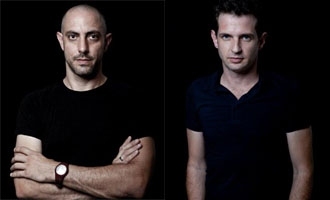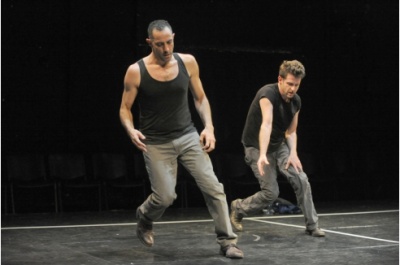 Niv Sheinfeld and Oren Laor from Israel work in tandem since 2004 and they combine contemporary dance, performance and physical theatre. Their pieces have been presented at prestigious festivals, such as Montpellier Danse (France), Tanz Im August and Mousonturm (Germany), Julidans and Noorderzon (the Netherlands). In the Czech Republic they participated in the last year’s 4+4 Days in Motion Festival and now they come to Tanec Praha Festival to perform the new piece Two Room Appartment (20th June 2013, Ponec Theatre).
The choreography Two Room Appartment is a remake of the piece created by Liat Dror and Nir Ben Gal in 1987 (Czech audience had the opportunity to see it in 1991 during TANEC PRAHA Festival). Which features are still the same and what is different in your version?
Niv Sheinfeld and Oren Laor from Israel work in tandem since 2004 and they combine contemporary dance, performance and physical theatre. Their pieces have been presented at prestigious festivals, such as Montpellier Danse (France), Tanz Im August and Mousonturm (Germany), Julidans and Noorderzon (the Netherlands). In the Czech Republic they participated in the last year’s 4+4 Days in Motion Festival and now they come to Tanec Praha Festival to perform the new piece Two Room Appartment (20th June 2013, Ponec Theatre).
The choreography Two Room Appartment is a remake of the piece created by Liat Dror and Nir Ben Gal in 1987 (Czech audience had the opportunity to see it in 1991 during TANEC PRAHA Festival). Which features are still the same and what is different in your version?Oren: Two months before the premiere of the work, after having copied all the material from the video and running it several times in the studio, we confronted a crisis. The movement was not ours, the nuances were not ours, the behavior was not ours – it was all theirs. We couldn’t tell whether we were being ourselves or representing Nir and Liat. It was elusive. But it was not only the question of who we are but also questions of artistic choices; some of the choices made in 1987 are not convincing for us today anymore.
So we decided to open up the work for improvisation in the studio. We took the liberty to cut material; to change and re-arrange material; to play with musicality, intensity, and speed; and to insert our own variations on Nir and Liat’s material. We also allowed ourselves to talk during the work if we felt we needed it. Scene by scene, we injected our own sensibilities and our own sense of authenticity into the work.
For example, in the original version there was a seduction scene in which Liat walks over to Nir and starts undressing him in an erotic way, leaving him in his underwear and shoes before walking away. We, on the other hand, had a totally different approach to this scene. We sought emotional, non-sexual intimacy in that moment, so we re-directed the scene. I strip to complete nudity in front of Niv and then climb into his arms like a child seeking comfort and protection, and Niv carries me and moves slowly, as if he is putting me to sleep. This scene became such an intimate scene for us that we couldn’t even leave the original soundtrack untouched; we needed to bring something that we will deeply relate to, something that is “our” music. So we decided to use Elton John’s Goodbye Yellow Brick Road. Niv: The fact that we are two men on stage – and they are a man and a woman – is by itself a major difference. Elements such as energetic output, nuances, balance, and tenderness all yield to a different set of expression and behavior when it comes to two men with high testosterone levels. The original work reflected on the issue of gender by looking into the eternal battle of the sexes; we, on the other hand, reflect on the issue of gender by looking into the relationship of two people of the same gender.
We also decided to have the public sit around the stage and not in front of it. We wanted to share our intimacy with the audience, and the proximity to the stage allows them to watch every detail and every nuance.
I would say that generally the process developed in three stages. First we had to re-write the text of the work in our bodies, and when we finished that stage, we were a representation of the text that Nir and Liat wrote. We were being “them.” In the second phase we decided to improvise, change, and allow talking while we move or in between movement sequences. We could speak about everything and ask any question that ran in our minds. This situation enabled two layers: one was their score and the second one was our reflection. In the third phase we fused these two elements into what today came to be our version of Two Room Apartment.
Who or what influenced your creative work the most?
Our sources of inspiration change<s> </s>from one production to another, and sometimes from one scene to another. The sources of inspiration as well as the starting point of the work are numerous– sometimes it’s an idea, sometimes it’s a reaction to things we see on the news, sometimes an emotion , sometimes a painting or a film,sometimes music. With Post-Martha for instance - the initial starting point was the specific play by Albee, because we found beauty and deep human compassion in it. In our recent work Ship of Fools the inspiration was the social climate in the society that we live in, and the need to make a critical comment or reflection about it.
In Two Room Apartment the influence is clear – Nir Ben Gal and Liat Dror's duet – that was the basis of this new work of ours.
One thing that is constant and a great source of inspiration for both of us is the performers that we choose to work with and the input that they bring with them.Even when we have a specific idea we are always curious to watch the performers’ interpretation of the idea.
Israeli contemporary dance scene is very rich and lively, brings up interesting topics and new physicality. How would you explain or define the Israeli dance?
Israel is situated in a very fragile part of the world – politically and socially. Living in areas of conflict raises many questions – moral questions, exi
 stential questions - for people and especially for artists, so in a way the atmosphere is always bubbly and vibrant. Of course you still find on Israeli stages a lot of the conservative aesthetics of modern dance, but if you look at the independant scene - there are several independant choreographers that aim to challenge concepts, raise questions about stage art and about dance, and also about physicality and aesthetics.
You visited Czech Republic for the first time last autumn during the 4+4 days in Motion Festival. What was your experience with the Czech audience like?
stential questions - for people and especially for artists, so in a way the atmosphere is always bubbly and vibrant. Of course you still find on Israeli stages a lot of the conservative aesthetics of modern dance, but if you look at the independant scene - there are several independant choreographers that aim to challenge concepts, raise questions about stage art and about dance, and also about physicality and aesthetics.
You visited Czech Republic for the first time last autumn during the 4+4 days in Motion Festival. What was your experience with the Czech audience like?It was one of the best performances that we had with Ship of Fools. We felt that the Czech audience really understood the show, all the nuances, all the humoristic parts, all the sensibilities that we put into the show... We felt in general that the communication with the Czech people was very flowing and free, the audience and also the people that we met in Prague during our stay. It felt that Czech and Israelis share the same codes of communication, the same sense of humor, the same sense of life, the same sense of sarcasm. We were very excited to receive the invitation to TANEC PRAHA this year and to meet again the Czech public. Niv Sheinfeld & Oren Laor (IL): Two Room Appartment
TANEC PRAHA 2013, 20.6. Ponec Theatre Niv Sheinfeld (1972) is a leading Israeli choreographer. He danced for five years with Liat Dror & Nir Ben-Gal Dance Company and then worked for 13 years as an independent choreographer, creating pieces for the Batsheva Ensemble and others, and collaborated with Emanuel Gat. He has won two major Israeli dance awards: the choreography award of the Israeli Ministry of Culture (2007) and the prestigious Rosenblum Award for Performing Arts. Sheinfeld also works as a schoolteacher in Jerusalem at the School of Visual Theater and the High Academy for Dance. Oren Laor (1971) studied theatre at Tel Aviv University. During his studies he collaborated on projects with many artists. Laor runs workshops for professional dancers, in which he combines methods of performance, body investigation and creation. He runs seminars at Ha'Kibbutzim Academy for Dance and Theatre, at Search Engine – school of Itzik Giuli and Yasmeen Godder, as well as for dancers at the company of Nir Ben Gal and Liat Dror and other arts groups.



